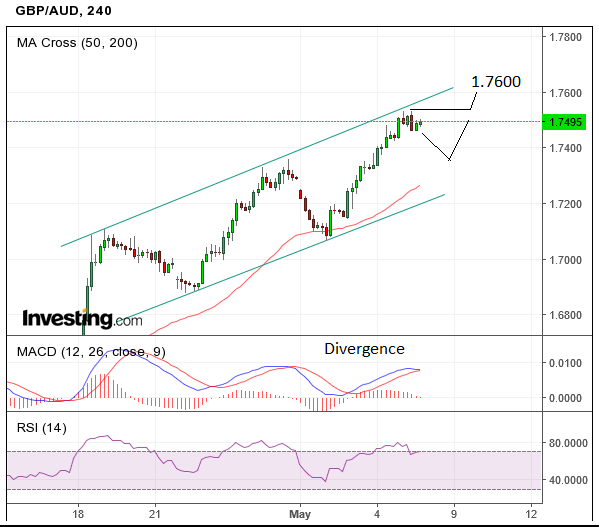GBP/AUD Rate: Pullback Possible?

The Pound to Australian Dollar exchange rate (GBP/AUD) has had a strong run higher in the previous week as falling commodity prices hit the outlook for the Australian economy.
In fact, the Australian Dollar has been one of the worst-performing currencies amongst a group of the world's biggest ten currencies this year.
As we note here, the currency is seen struggling as iron ore prices come off the boil, and there is no suggestion that a notable recovery in the commodity's price is likely near-term.
Nevertheless, we now note some signs of a potential overbought scenario in the pair.
The exchange rate has reached the upper boundary of its rising channel on the four-hour chart and we see a good chance of a short-term pull-back to 1.7300 before it rotates and moves higher.
If the exchange rate breaks above the 1.7500 highs it should rise to a target at 1.7600 eventually.
Bulls should remain cautious as the exchange rate is diverging with momentum measured both by MACD and RSI.
The divergence is due to the exchange rate making successively higher highs which are not corroborated by momentum which is declining instead and making successively lower lows.
The exchange rate has made higher highs on three occasions whilst momentum has made lower lows at the same time, and this alone is a sign that the exchange rate is about to weaken, especially if price action forms a reversal pattern.

Data for the Australian Dollar
The Aussie is trading against a fundamental backdrop of falling commodity a 7% fall in oil and iron ore, a drop of 5% in copper prices and a drop of 3% in gold prices although this was offset to some degree by positive data from Australia which showed an acceleration in manufacturing, service and construction sector activity.
The main release for the Australian Dollar in the week ahead is March Retail Sales on Tuesday, May 9 at 2.30 GMT; which is forecast to show a rise of 0.3% from -0.1% in the previous month of February.
The government will also announce its Budget on Tuesday. This could inform the outlook for the country’s tenuous AAA credit rating. If the budget is big on spending and short on fiscal discipline it could lead to a downgrade from S&P, and a consequent fall in the Aussie.
Data for the Pound
The main release for the Pound is the Bank of England rate meeting and the BOE May inflation report at 12.00 GMT on Thursday, May 11.
No change in policy is forecast because of the ‘purdah’ preventing the authorities from making changes to rules in the run-up to the election.
The BOE may downgrade growth expectations and raise inflation (notwithstanding the recent fall in oil), but according to analysts at Canadian lender TD Securities, the governor is expected to, “steer things back to neutral during the presser.”
Barclays expect the communication to be slightly hawkish, in an effort to boost the Pound and keep inflation at bay. Like TD they also see the bank likely to forecast inflation to rise and GDP to fall, although only in 2017 as falling oil prices will bite in 2018.
“As for the communication, we believe the Committee will be eager to repeat its slightly hawkish message from the February inflation report, keeping the focus on inflation, and banking on the support provided to sterling to mitigate risks of excessively high and sticky inflation. Changes in forecasts will be consistent with such a move sideways as we expect GDP growth to be revised slightly lower but inflation slightly higher.
Other important data released this week includes the RICS House Price Balance (Apr) at 00.01 on Thursday, May 11, Industrial and Manufacturing Production at 09.30 on the same day and also at 9.30 the Trade Balance in March.





